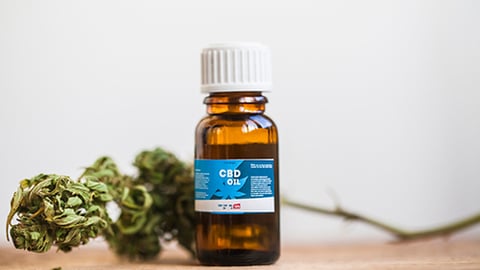4 Things All Grocers Need to Know About CBD
CBD, short for cannabidiol, has been cited as one of 2019’s top trends in food, wellness and retail. It’s being talked about everywhere, from national news programs to office water coolers. In fact, during the past six months, I’ve been asked a wide variety of questions about CBD by family, friends, business associates and retailers, among them: What is CBD? What is it used for? And why am I hearing about it now?
CBD is a naturally occurring compound found in the cannabis plant. Hemp-derived CBD comes in many product forms, from oil tinctures to topical creams. When CBD is ingested or applied to the skin, it is believed to interact with the body’s endocannabinoid system, which regulates functions such as mood, appetite and sleep. And unlike hemp’s cousin marijuana, hemp-derived CBD contains trace amounts of the compound THC (tetrahydrocannabinol), meaning that users of hemp-derived CBD will likely not experience psychoactive effects.
Consumer interest in CBD has been steadily growing in recent years. Last year, the market exploded following the passage of the 2018 Farm Bill. The legislation removed hemp from the Controlled Substances Act, deeming it a legal agricultural commodity and redefining “hemp” to include any part of the plant with less than 0.3 percent THC, including “extracts, cannabinoids and derivatives.”
The hemp-derived CBD category is predicted to grow to $22 billion dollars by 2022. As a result, a wide range of retailers — especially grocers — are exploring how CBD can bring in new shoppers, grow foot traffic, and help expand the health and beauty category. In addition to incremental growth opportunities, CBD products offer attractive profit margins.
Here are four things grocers should consider before taking the leap into CBD product sales:
-
Understand the Regulatory Landscape
While the 2018 Farm Bill created a pathway toward full legalization of hemp nationwide, things are still a little murky when it comes to CBD. In fact, the U.S Food and Drug Administration (FDA) has commented that under current regulations, CBD can’t be added to food or marketed as a dietary supplement. The FDA is reviewing its position, which may result in proposed regulations; however, if or when that change will occur is still unclear. At the same time, some states have enacted legislation that permits the production, sale and use of CBD in various forms.
The first thing grocers should do prior to stocking shelves with CBD products is to familiarize themselves with federal, state and local laws. Consumer demand will ultimately determine product assortment, but by understanding all applicable laws, retailers can appropriately tailor product offerings.
-
Determine Risk Tolerance
Given the FDA’s current position on CBD in food and dietary supplements, topicals, such as creams, salves, serums and makeup applied to the skin, have emerged as grocers’ current CBD products of choice. Many major grocery chains are already stocking these products while waiting for additional clarification in the form of regulations from the FDA regarding its position on CBD. Meanwhile, grocers in states where ingestible CBD products are legal at the state level have begun expanding their assortments to include supplements, edibles and beverage products.
-
Education is Critical
In addition to understanding the evolving regulatory landscape, grocers also need to educate themselves about CBD to help consumers make informed purchases. Since the category is new, there’s a general lack of factual information about CBD. This knowledge gap creates an opportunity for grocers to be a trusted source of information for those purchasing CBD products.
Unfortunately, there have been documented instances of companies and brands trying to pass off inferior products. To combat this, grocers need to identify brands offering high-quality and accurately labeled products. Look for brands that provide ample product information on their packaging and/or websites, including the source of raw materials, manufacturing details and an avenue to inquire about more information.
-
Research, info on CBD are Continually Growing
Research on CBD is being conducted at a rapid pace. Grocers should find the most recent and credible information on CBD products. Sources of good information include government agencies and universities that are partnering on research into the benefits of cannabinoids, new-use cases and advances in hemp production. Additionally, as third-party data companies begin to capture sales data, the role of science and category management will play a big part in helping to drive brand and assortment decisions.
Moving forward, we will continue to learn about CBD products, the ways they fit into consumers’ lives and how they'll be managed through regulation. Research and laws will evolve. Product categories and applications will expand. For now, one thing is certain: The industry is continuing to grow at a rapid pace and will create new opportunities for grocers in the year ahead.







